
Physalia physalis floating in the sea (Image by Corbis)
Table of Contents
How is it different from jellyfishes?
Physalia physalis been mistaken as jellyfishes as they look similar and are able to sting when you come into contact with them. Jellyfishes are single cell organisms. On the other hand, Physalia physalis is s siphonophore (a group of animals closely related to jellyfishes) and is made up of different specialised individuals called zooids. [4]We are able to tell Physalia physalis and jellyfishes apart by their colours. Physalia physalis has a distinct blue and purple colour (pink outline when looked up close) while most jellyfishes are translucent. [3] Physalia physalis are usually found on the surface of water due to its chamber filled with gas compared to jellyfishes which are submerged in the water.
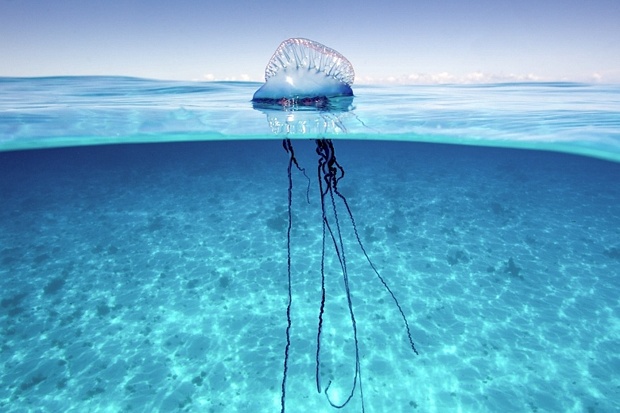
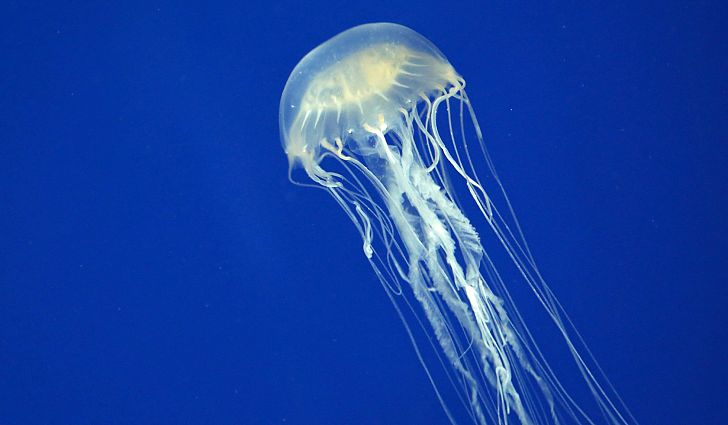

There is also a closely related species P. utriculus (also known as Blue bottle). However, is twice in size with the length of 30cm, width of 12cm and tentacles that can go up to 50m. [9] P. utriculus is less widely distributed, mainly found in Australia and Hawaii, whereas P. physalis is found in many parts of the world. [5, 7]
Portuguese Man-of-War
Physalia physalis has a common name: Portuguese Man-of-War. It came from its resemblance to the powerful Portuguese battleships which were famous during the 16th to 19th century. [3]
Man-of-War on a shore (Image by Wallace)

Cross section of Man-of-War battleship (Image by Kindersley)
Deadly but Beautiful
Stings from P. physalis can be fatal and for serious cases, the venom is able to cause airway blockage, heart and lung problems and even kill young children. [7, 11] As such, this creature has been feared by many when they are swimming in the seas and are even called 'nightmare'.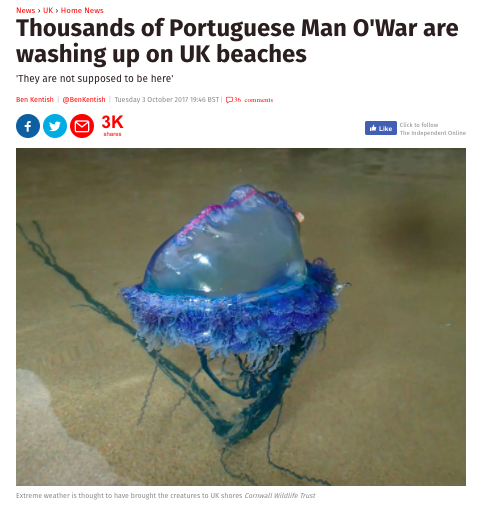
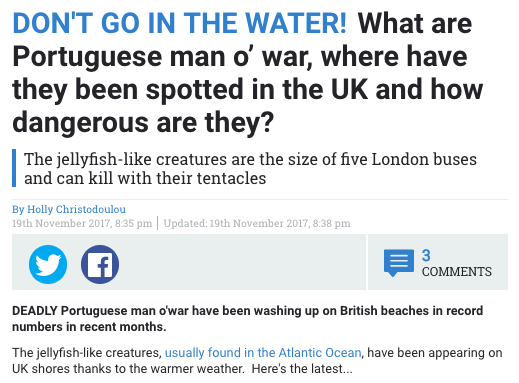
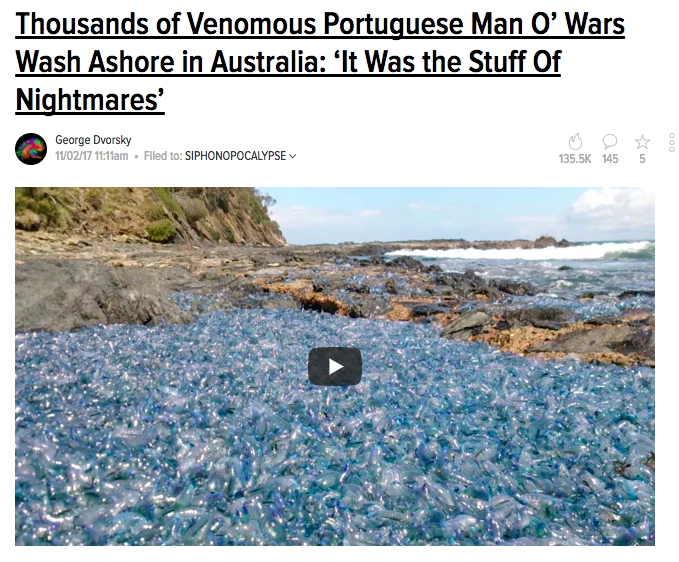
Articles of P. physalis reported causing fears of residents and tourists (Image from Independent, The Sun and Gizmodo)
Physalia physalis has caused harm to the tourism of countries as tourists avoid beaches where they are present. A large amount of money is spent on treating the stings from this organism. [10] They also impact negatively on the fishing industry as they feed heavily on fish larvae. The increase in P. physalis population will result in a decline in fishes that are available as the source of food to humans. [9]
Although not an endangered species, the loss of these animals can lead to adverse effects. In no circumstances these animals should be harmed or even "popped".
<iframe width="560" height="315" src="https://www.youtube.com/embed/W_sjnmP81I4?start=101" frameborder="0" allowfullscreen></iframe>
Spiteful behaviour of a citizen killing P. physalis (Video from Dayla)
Physalia physalis is a beautiful creature that is loved by many photographers. "They're incredibly beautiful animals." says Dunn Ansarov, an evolutionary biologist whom compares P. physalis to artwork created by renowned glass sculptor, Dale Chihuly. [15]
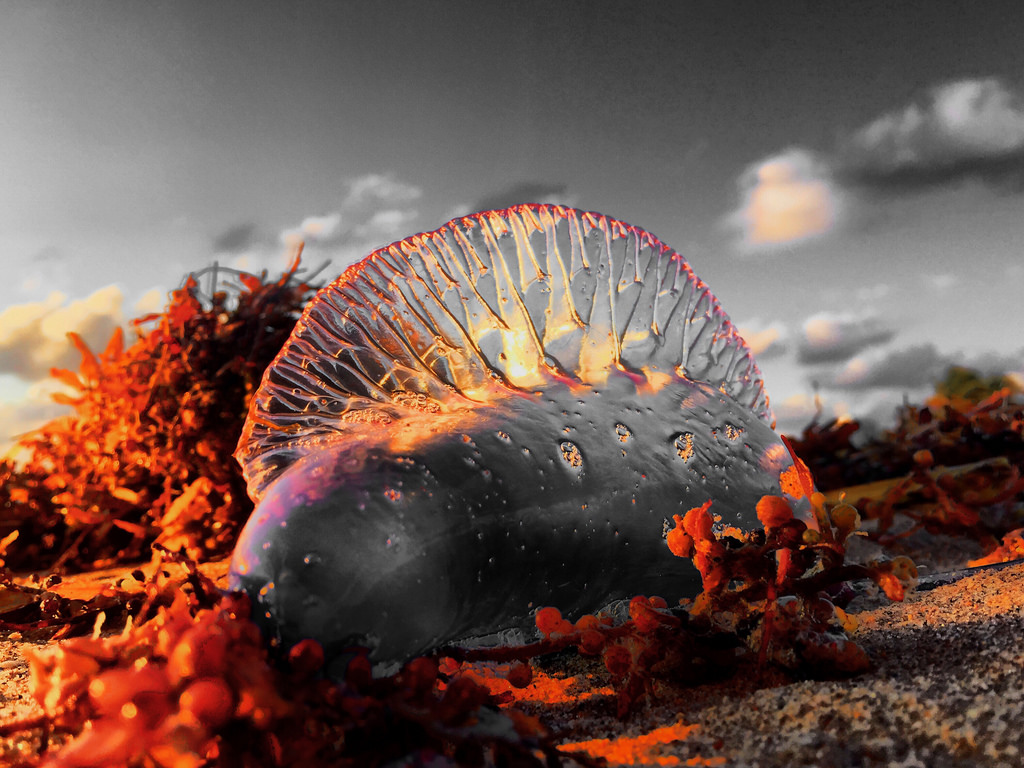
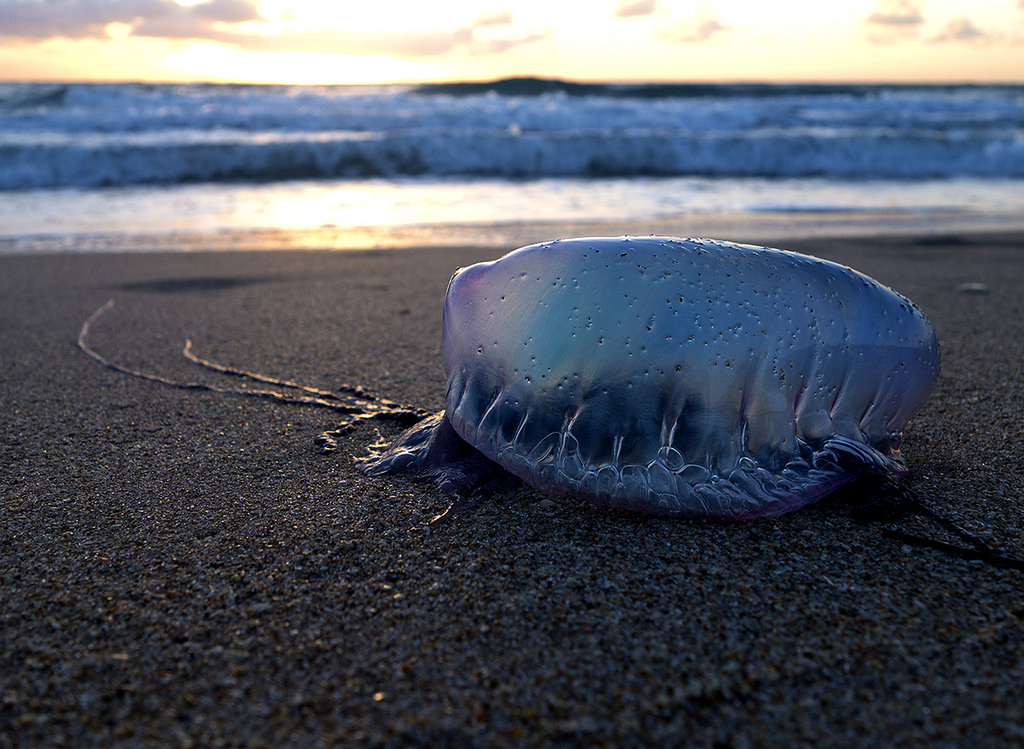
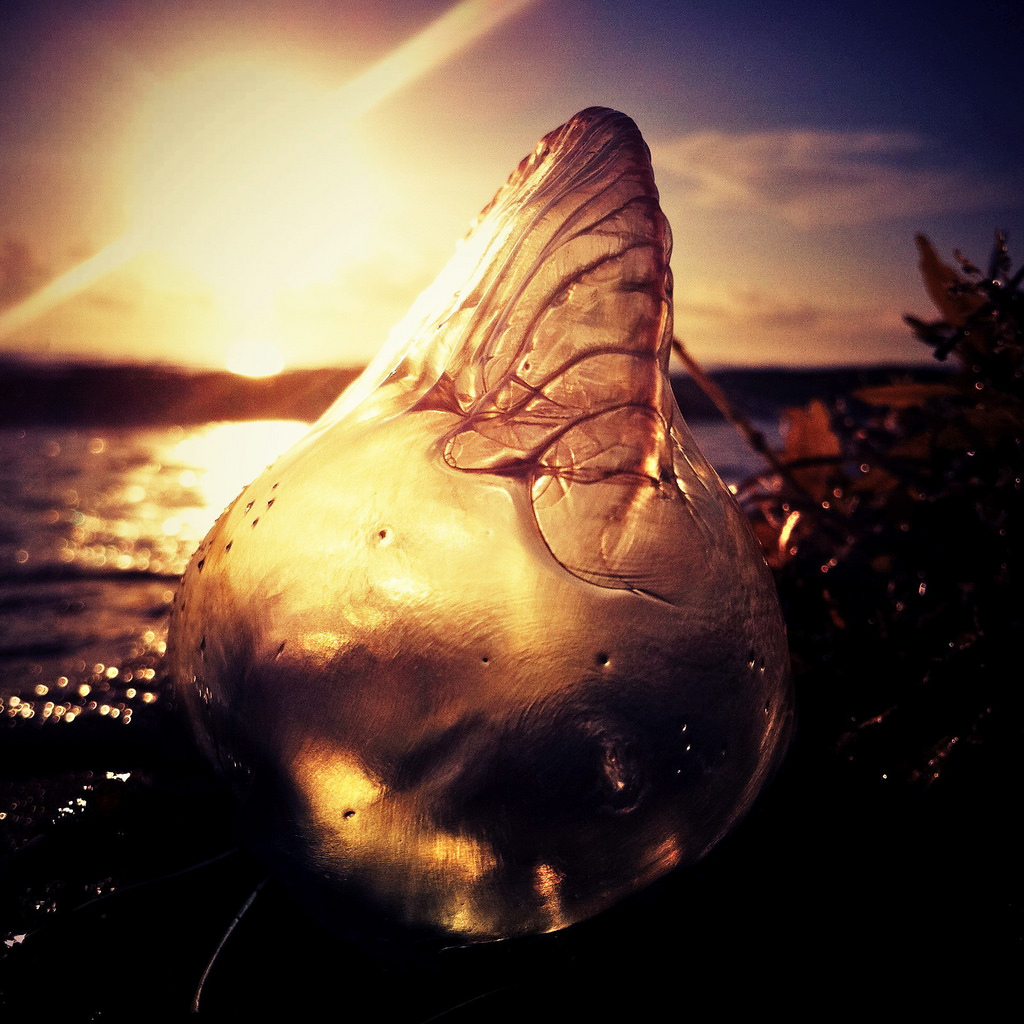
Aesthetically pleasing photos taken by citizen photographers sing iPhone (Image by Royston and Smschelb)
Stunning video of the close up of P. physalis (Video by National Geographic)
Not only as a food source for fishes (eg. Ocean sunfish), turtles (eg. Loggerhead turtle), mollusks (eg. Blue sea slug), octopuses (eg. Blanket octopus) and crustaceans (eg. Pacific sand crab), P. physalis also keeps the balance in the ecosystem. [9, 10]
Video of predators feeding on P. physalis (Video by National Geographic)
How to deal with its stings?
Venom from P. physalis can be recognised from extremely painful wounds that look like whip wounds. The pain usually lasts for 15 minutes to 1 hour.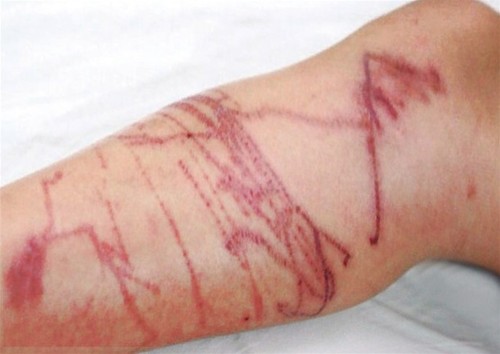
Treatment
Remove tentacles from the skin. Do not remove them with bare hands and avoid touching other parts of the skin. Stinging cells are still harmful even if the organism is no longer alive. Thoroughly wash the wound with seawater not freshwater as it may trigger the cells and irritate the skin further. [13, 14] After, rinse with warm water to soothe the pain. If allergic reactions occur, seek medical attention immediately. [9, 12]Myth debunked
Peeing on the wound will not help in relieving pain from the victim. It may even cause more pain and aggravates the stinging cells to discharge the venom from the unfired ones. [13, 14]Description
Physalia physalis does not have head, brain, gills or skeleton. It consists of 4 zooids: pneumatophore (float), dactylozooids (tentacles), gastrozooids (stomach) and gonozooids (sex organs). [7, 10]
Pneumatophore (Float)
Pneumatophore is also called the float which is oblong-shaped. [2] It is made up of a bladder-like container filled with gas (carbon monoxide, oxygen and argon) and outer muscular case with a crest. The crest acts as a sail and helps the organism to travel by drifting, with the wind and the water determining its direction. [7, 9] By contracting and relaxing the outer muscles, the float is able to raise or lower the crest. It also can adjust how deep it is submerged into the water by changing the gas density in the air bladder with the help of a gas gland on the inner layer of the float. [6]Dactylozooids (Tentacles)
Also known as the tentacles, it is used for defence and capturing of its prey. Dactylozooids are covered with nematocysts (stinging cells) which are responsible for its stings. [2] These cells contain venom that is fired into its prey. The venom is a neurotoxin which attacks the nerve tissue and can cause paralysis. The tentacles will then contract and bring in the paralysed prey to the gastrozooids for digestion of food. These tentacles have the capability to regenerate. [7]Video of P. physalis feeding (Video from BBC)
Gastrozooids (Stomach)
This polyp is reddish-brown in colour as it accumulates haemoglobin from the blood of its prey. [6] It is responsible for providing nutrients to the whole organism. Gastrozooids are long tubes with a mouth at the end that will open, release and spread digestive enzymes on the food. Digested nutrients are then circulated to different parts of the organism. [2, 9]Gonozooids (Reproductive organ)
Gametes (sex cells) are formed in gonozooids and are shed into the water. [2, 10] The sperm of a colony will join with the egg of another subsequently giving rise to new organisms. It is also able to reproduce via asexual reproduction, budding and mitotic division. [5, 9]Dactylozooids, gastrozooids and gonozooids are known as the tripartite group as they are not able to survive independently and need to work together. As an adult P. physalis, they can have up to hundreds of this tripartite groups. [6]
Biology
Prey
As a carnivore, small soft-bodied creatures such as fishes and their larvae are preferred. [2, 9] They do not have a specific preference for food as they are unable to see. They "fish" blindly and eat everything that gets stung by its tentacles.Predators
Caretta caretta, commonly known as loggerhead sea turtles have thick skin, tongue and throat. The stings of P. physalis is unable to penetrate. [7, 9] Hence, it is commonly eaten by the loggerhead sea turtles.Tremoctopus or Blanket Octopus is immune to its venom. Young octopuses even carry tentacles from the P. physalis for offensive and defensive purposes. [2]
Symbiosis
Symbiosis refers to the relationship between two species that live closely together. [8]Physalia physalis and Nomeus gronorii (also known as the Man-of-War fish) have a mutualism symbiotic relationship where both parties benefit. [7] The fish lives among the tentacle of P. physalis and feed on them while avoiding the dactylozooids. Although the fish is not immune to the venom, it is able to tolerate it better than other fishes. [7] It also relies on its speed and agility to avoid the stings. The fish also feeds on the leftovers from the food ofP. physalis. At the same time, it is protected from other predators due to the harmful tentacles. Physalia physalis benefits from this relationship as it is able to use the fishes as lure to attract other prey into the tentacles. [9]

Distribution
Physalia physalis floats on warm, tropical and subtropical marine waters all over the world. [9, 10]
Georeferenced records of Physalia physalis (Image by Global Biodiversity Information Facility)*
*Distribution may not be accurate as records are from citizens who have recorded their sightings at GBIF
This is due to them only being able to move only if they are pushed by the winds and waves. Occasionally they can be washed up on the beaches or seen floating in thousands due to extreme weathers or hurricanes. [3]
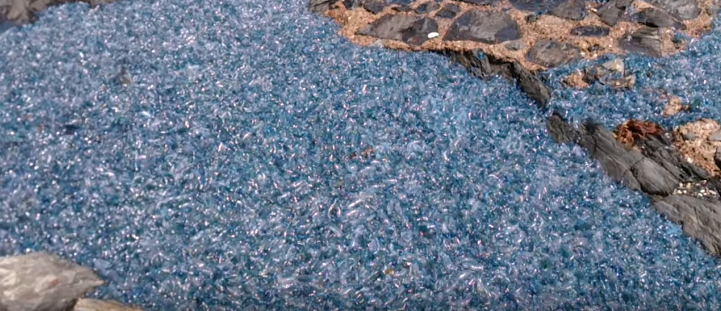
Thousands of Physalia physalis washed on shore in Australia (Image by Waitensky)
Taxonomy and Systematics
Name
Binomial name: Physalia physalis (Linnaeus, 1758)Original decription found in: Systema Naturae per regna tria naturae, secundum classes, ordines, genera, species, cum characteribus, differentiis, synonymis, locis. Editio decima, reformata. Laurentius Salvius: Holmiae. [1]
Common name: Portuguese Man-of-War
Synonyms: Medusa utriculus (Gmelin,1788), Physalia utriculus (Gmelin, 1788), Physalia pelagica (Lamarck, 1801)
Specimen
Specimens are found in National History Museum, London.
Taxonomic classification
| Kingdom |
Animalia |
| Phylum |
Cnidaria |
| Subphylum |
Medusozoa |
| Class |
Hydrozoa |
| Subclass |
Hydroidolina |
| Order |
Siphonophora |
| Suborder |
Cystonectae |
| Family |
Physaliidae |
| Genus |
Physalia |
| Species |
P. physalis |
The family Physaliidae is monotypic which has only one genus: Physalia. [2]
DNA Barcode

The barcode sequence was retrieved from BOLD and GenBank of the Cytochrom oxidase subunit 1 region. [17]
Molecular phylogenetics [18]
Its order Siphonophora includes marine organisms that are made up of specialised animals called zooids. These zooids each are specialised and have their own special function which has been taken into great interest by scientists. Siphonophores are highly polymorphic pelagic cnidarians which are known as superorganisms due to its division of labour between polyps and medusae. Its phylogeny was inferred based on nuclear small subunit ribosomal RNA gene (18S) and the mitochondrial large subunit ribosomal RNA gene (16S). The degree of mutational saturation was assessed by comparing the number of observed nucleotide differences between each possible species pair against the corresponding number of inferred differences.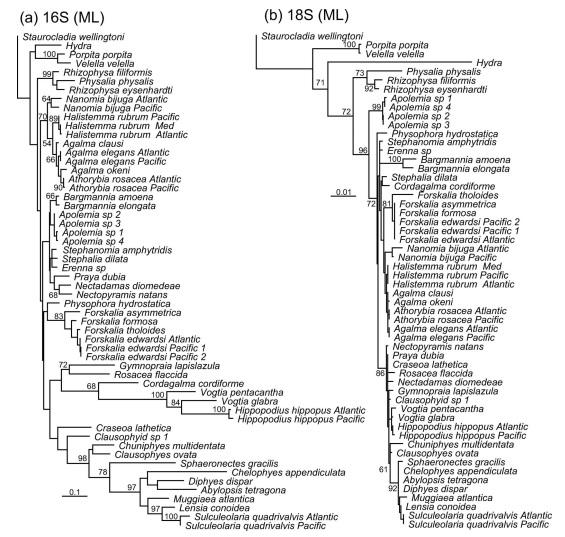
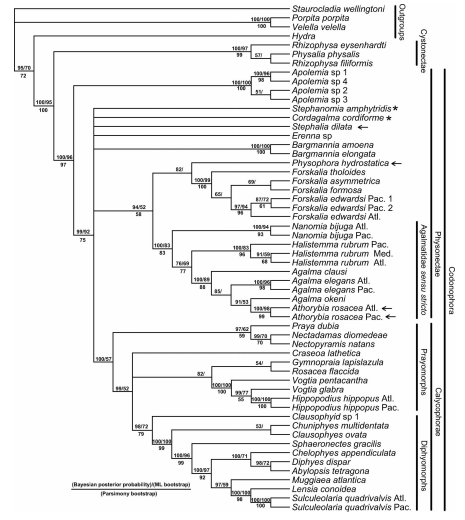
Left score above branch is Bayesian posterior probability (%) and below the branch is MP bootstrap support value (%)
Literature and References
[1] Linnaei C. (1758) Systema Naturae per regna tria naturae, secundum classes, ordines, genera, species, cum characteribus, differentiis, synonymis, locis. Editio decima, reformata. Laurentius Salvius: Holmiae.[2] Hoover M. (n.d.) Portuguese Man-of-war (Physalia physalis). Marine Invertebrates of Bermuda.
[3] Portuguese Man-of-War. (n.d.) Invertebrates. Animals. National Geographic.
[4] Watson S. (2006) How Jellyfish Work. HowStuffWorks.com.
[5] Indo-Pacific Portuguese Man-Of-War. (1998) Marine Life Profile. Education Department. Waikiki Aquarium at the University of Hawai'i-Mano.
[6] Ma E. (2016) Infocus: What is the Portuguese Man-O'-War?. Anatomy To You.
[7] Editors of Encyclopaedia Britannica. (n.d.) Portuguese man-of-war. Invertebrate. Brtitannica.
[8] Examples of Symbiosis. (n.d.) The Human Microbiome. Learn.Genetics. Genetic Science Learning Center.
[9] Riss N. (2006) Portuguese Man of War, Physalia physalis. Human Interaction.
[10] Kurlansky M. B. (2002) Physalia physalis Portuguese man-of-war. Animal Diversity Web. University of Michigan. Museum of Zoology.
[11] Keay L. (2017) Incredible time lapse footage reveals a deadly Portuguese man o' war writhing and squirming as it lives out its last few hours after washing up on a UK beach. Mail Online.
[12] Slater M. (2017) What should you do if you spot or get stung by a Portuguese Man O' War?. ITV News.
[13] Curtin C. (2007) Fact or Fiction?: Urinating on a Jellyfish Sting is an Effective Treatment. Scientific American.
[14] Dvorsky G. (2017) Science Reveals the Right Way to Treat a Man O' War Sting. Gizmodo.
[15] Lee J. J. (2014) Deadly beautiful. A Portrait of the Portuguese Man-of-War. National Geographic.
[16] Physalia physalis. ITIS Report.
[17] Barcode data: Physalia physalis. Encyclopedia of Life Data Systems.
[18] Dunn C. W., Pugh P. R., Haddock S. H. D. (2005) Molecular Phylogenetics of the Siphonophora (Cnidaria), with Implications for the Evolution of Functional Specialization.